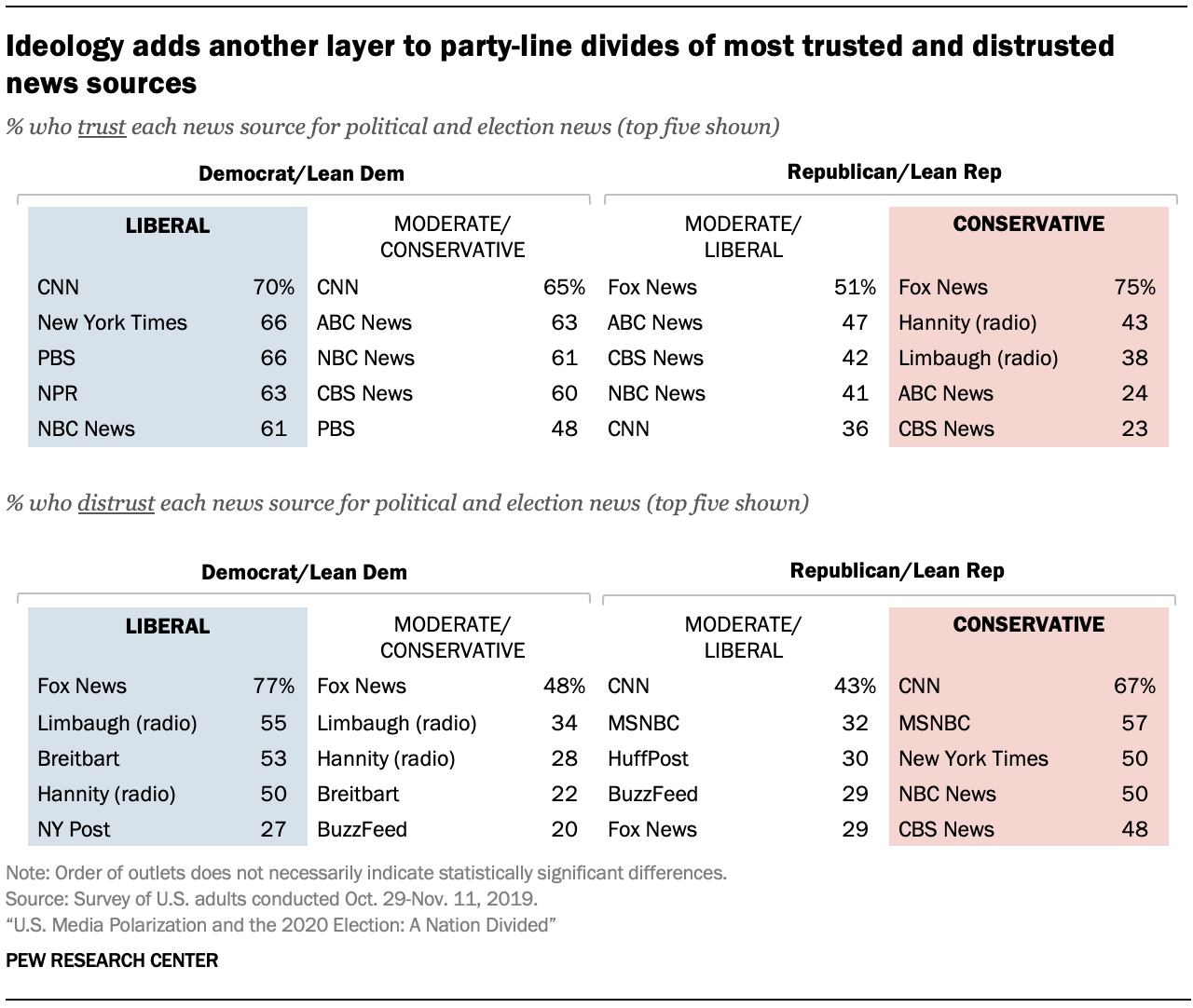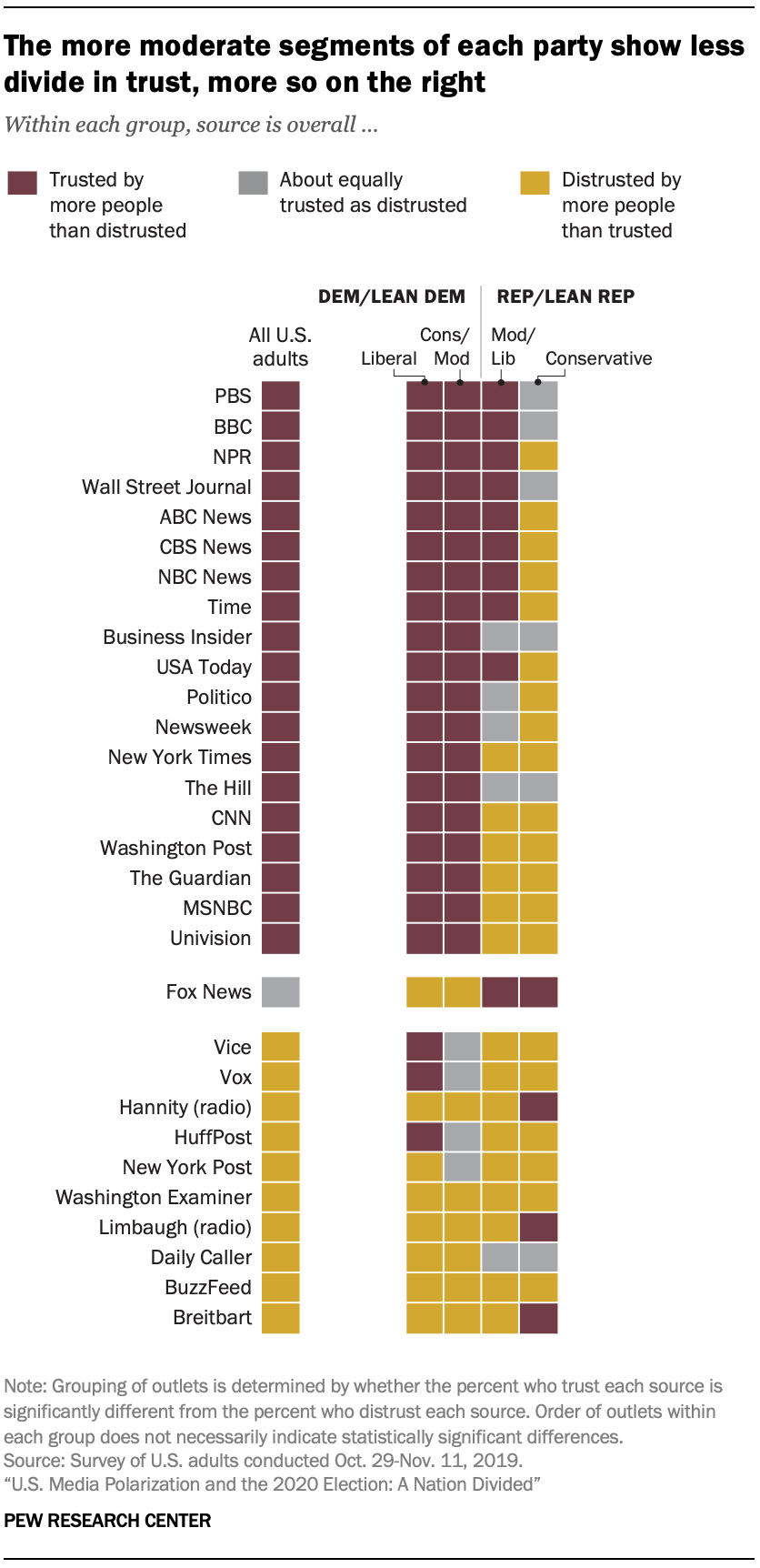The differences in trust and distrust of news outlets are often wider among the ideological wings of each party — conservative Republicans and liberal Democrats.
One way to see this is to look at the two cable channels that most clearly represent the polarized media universe. Among all Republicans and Republican leaners, CNN is trusted by 23% and Fox is trusted by 65%. Among conservative Republicans and Republican leaners, trust drops to 16% for CNN and climbs to 75% for Fox News.

The same phenomenon can be seen among Democrats and Democratic leaners. The trust level for Fox News among all Democrats is 23%, but it drops significantly to 12% among liberal Democrats. The percentage who trust CNN is roughly the same among all Democrats (67%) and among liberal Democrats (70%).
Overall then, the CNN “trust gap” between conservative Republicans (16%) and liberal Democrats (70%) is fully 54 percentage points. And the gap in trust of Fox News is even larger at 63 points (trusted by 75% of conservative Republicans and 12% of liberal Democrats).
Conservative Republicans and liberal Democrats also look even more dimly at sources that are already widely distrusted by Republicans and Democrats in general. For example, the Sean Hannity radio show is distrusted by 38% of Democrats and Rush Limbaugh is distrusted by 43%. Among liberal Democrats, distrust rises to 50% and 55%, respectively.
Similarly, MSNBC is distrusted by 47% of Republicans overall but by 57% of conservative Republicans. The New York Times is distrusted by 42% of all Republicans, yet by half of all conservative Republicans (50%).
These differences can be examined from the other direction as well. While Sean Hannity is trusted by 30% of all Republicans, he is trusted by 43% of conservative Republicans. The same is true for Limbaugh, whose trust level rises from 27% among all Republicans to 38% among conservatives.
On the other side of the aisle, The New York Times is trusted by 53% of all Democrats. But among liberal Democrats, that number jumps to 66%.
Some of these views about media credibility also are reflected in how often sources are used. Among all Republicans, 19% say they got political and election news from the Sean Hannity radio show in the past week. But about a quarter of conservative Republicans (27%) did so.
About one-third of all Democrats (31%) received political news from The New York Times in the past week. Liberal Democrats were even more faithful consumers, with 42% saying they got news from the Times in the past week.

Within both partisan groups there are ideological differences in views and use of news sources – these are particularly pronounced among Republicans. For example, there are 20 sources more conservative Republicans distrust than trust. That number falls to 15 sources among moderate and liberal Republicans. And though only four sources are trusted more than distrusted by conservative Republicans, there are 10 that moderate and liberal Republicans trust more than distrust.
In evaluating the credibility of the three major commercial broadcast networks, moderate and liberal Republicans are far more likely to trust ABC, CBS and NBC News than conservative Republicans.
For Fox News specifically, support softens among moderate and liberal Republicans. Three-quarters of conservative Republicans (75%) trust it; only 12% distrust it. Among moderate and liberal Republicans, about half (51%) say they trust Fox News and 29% distrust it.
There are also some distinctions within parties about the use of sources for political and election news. Fox News is easily the most turned to source for all Republicans, but while about two-thirds of all conservative Republicans (68%) got political news there in the past week, only about half of moderate and liberal Republicans (46%) did. And, while about a quarter of conservative Republicans got political news last week from the Sean Hannity radio show (27%) and Rush Limbaugh (23%), those numbers plunge to 7% and 6%, respectively, for moderate and liberal Republicans.
The differences between conservative and moderate Democrats and liberal Democrats aren’t as pronounced as those on the Republican side, but there are some. For example, while 55% of liberal Democrats distrust Rush Limbaugh, that number drops to 34% among conservative and moderate Democrats. The same is true for Sean Hannity, where the level of distrust drops from 50% among liberal Democrats to 28% for conservative and moderate Democrats.
There are other distinctions within the Democratic party when it comes to getting political and election news. For example, 42% of liberal Democrats got political news from The New York Times in the past week compared with 22% of conservative and moderate Democrats. A similar pattern is seen with The Washington Post, where one-third of liberal Democrats (33%) got political news last week compared with 20% of conservatives and moderates. Finally, while only 15% of liberal Democrats say they got news from Fox News in the past week, about twice as many moderate and conservative Democrats (29%) say they did so.